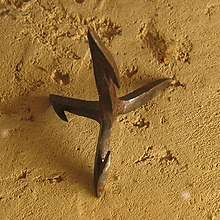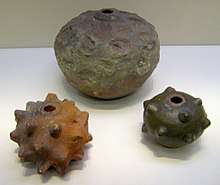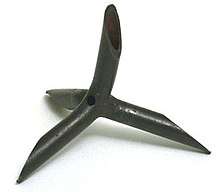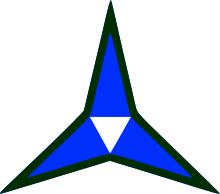Caltrop
A caltrop (also known as caltrap, galtrop, cheval trap, galthrap,[1] galtrap, calthrop, jackrock or crow's foot[2][3]) is an area denial weapon made up of two or more sharp nails or spines arranged in such a manner that one of them always points upward from a stable base (for example, a tetrahedron). Historically, caltrops were part of defences that served to slow the advance of troops, especially horses, chariots, and war elephants, and were particularly effective against the soft feet of camels.[4] In modern times, caltrops are effective when used against wheeled vehicles with pneumatic tires.

Name
The modern name "caltrop" is derived from the Latin calcitrapa (foot-trap),[5] such as in the French usage chausse-trape. The synonymous Latin word tribulus provides part of the modern Latin name of a plant commonly called the caltrop, Tribulus terrestris, whose spiked seed case can injure feet and puncture tires. This plant can also be compared to Centaurea calcitrapa, which is also sometimes referred to as the "caltrop". A water plant with similarly-shaped spiked seeds is called the "water caltrop", Trapa natans.
History

Caltrops were known to the Romans as tribulus[6] or sometimes as murex ferreus,[7] the latter meaning "jagged iron" (literally "iron jagged thing"). In Ancient Greek the word "tribalos" meant three spikes. They were also used in the Battle of Carrhae in 53 BC.[8]
The late Roman writer Vegetius, referring in his work De re militari to scythed chariots, wrote:[9]
The armed chariots used in war by Antiochus and Mithridates at first terrified the Romans, but they afterwards made a jest of them. As a chariot of this sort does not always meet with plain and level ground, the least obstruction stops it. And if one of the horses be either killed or wounded, it falls into the enemy's hands. The Roman soldiers rendered them useless chiefly by the following contrivance: at the instant the engagement began, they strewed the field of battle with caltrops, and the horses that drew the chariots, running full speed on them, were infallibly destroyed. A caltrop is a device composed of four spikes or points arranged so that in whatever manner it is thrown on the ground, it rests on three and presents the fourth upright.
Another example of the use of caltrops was found in Jamestown, Virginia, in the United States:[10]
Undoubtedly the most unusual weapon or military device surviving from seventeenth-century Virginia is known as a caltrop, a single example of which has been found at Jamestown. It amounts to a widely spread iron tripod about three inches long with another leg sticking vertically upward, so that however you throw it down, one spike always sticks up. ... There is no doubt that the most inscrutable Indian treading on a caltrop would be shocked into noisy comment. ... The fact that only one has been found would seem to suggest that they were used little, if at all. As with all military equipment designed for European wars, the caltrop's presence in Virginia must be considered in the light of possible attacks by the Spaniards as well as assaults from the Indians.
The Japanese version of the caltrop is called "makibishi". Makibishi were sharp spiked objects that were used in feudal Japan to slow pursuers and also were used in the defence of samurai fortifications. Iron makibishi were called "tetsubishi", while the makibishi made from the dried seed pod of the water caltrop, or water chestnut (genus Trapa), formed a natural type of makibashi called "tennenbishi". Both types of makibishi could penetrate the thin soles of shoes, such as the waraji sandals, which were commonly worn in feudal Japan.[11][12]
Similar devices


Punji sticks perform a similar role to caltrops. These are sharpened sticks placed vertically in the ground. Their use in modern times targets the body and limbs of a falling victim by means of a pit or tripwire.
During the Second World War, large caltrop-shaped objects made from reinforced concrete were used as anti-tank devices, although it seems that these were rare.[13] Much more common were concrete devices called dragon's teeth, which were designed to wedge into tank treads. Large ones weighing over 1 tonne (1.1 tons) are still used defensively by the army to deny access to wheeled vehicles, especially in camp areas. As dragon's teeth are immobile, the analogy with the caltrop is inexact. Another caltrop-like defence during World War II was the massive steel, freestanding Czech hedgehog; the works were designed as anti-tank obstacles, and could also damage landing craft and warships that came too close to shore. These were used by the Germans to defend beaches at Normandy and other coastal areas.
Tetrapods are concrete blocks shaped like caltrops, which interlock when piled up. They are used as riprap in the construction of breakwaters and other sea defences, as they have been found to let the water pass through them and interrupt natural processes less than some other defenses.
Modern uses
Tyre deflation device

Researchers have tried to develop a caltrop-like device to deflate vehicle tyres in a manner useful to law enforcement agencies or the military.[14][15]
World War I
During service in World War I, Australian Light Horse troops collected caltrops as keepsakes. These caltrops were either made by welding two pieces of wire together to form a four-pointed star or pouring molten steel into a mould to form a solid, seven-pointed star. The purpose of these devices was to disable horses. They were exchanged with French troops for bullets. The Australian Light Horse troops referred to them as "Horse Chestnuts".
World War II
Caltrops were used extensively and effectively during World War II. The modifications and variants produced by the Special Operations Executive (SOE) and the Office of Strategic Services (OSS) of the United States [16] are still in use today within special forces and law enforcement bodies.
The Germans dropped crowsfeet.[17] These were made from two segments of sheet metal welded together into a tetrapod with four barbed points and then painted in camouflage colours. They came in two sizes with a side length of either 3 or 2 1⁄2 inches (76 or 64 mm). They were dropped from aircraft in containers the same size as a 500 kg bomb and were dispersed by a small explosive charge. They were used to attack airfields and roads with a view to bursting tyres.[17][18]
Labour activists
Caltrops have been used at times during labour strikes and other disputes. Such devices were used by some to destroy the tyres of management and replacement workers.
Caltrops, referred to as "jack rocks" in news articles, were used during the Caterpillar strike of the mid-1990s, puncturing tyres on vehicles crossing the picket line in Peoria. Because of their small size and the difficulty proving their source, both the company and the United Auto Workers blamed each other. Collateral damage included a school bus and a walking mail carrier.[19] In Illinois, the state legislature passed a law making the possession of such devices a misdemeanor.[20][21]
Symbolic use

A caltrop has a variety of symbolic uses and is commonly found as a charge in heraldry.[22] For instance, the Finnish noble family Fotangel (Swedish for 'caltrop') had arms gules, three caltrops argent.
It has also been adopted by military units: the caltrop is the symbol of the US Army's III Corps, which is based at Fort Hood, Texas. III Corps traces its lineage to the days of horse cavalry, which used the caltrop as a defensive area denial weapon.
The caltrop is also the symbol of the United States Marine Corps' 3rd Division, formed on 16 September 1942.
The Savannah Association annually commemorate "Operation Savannah" a battle from 1975 to 1976 in the South African Border War also known as the Namibian War of Independence. The battle involved a covert intervention by the South African Defence Force's (SADF) during the interrelated Angolan War of Independence, subsequent Angolan Civil War and Namibian War of Independence. During this battle many South African soldiers earned the Honoris Crux for bravery against Angolan and Cuban forces. Their insignia was a caltrop.
See also
| Wikimedia Commons has media related to Caltrops (weapon). |
- Booby trap
- Czech hedgehog
- Knucklebones, a game, with similar hazards
- Makibishi
- Spike strip
- Tribulus terrestris, a plant
- Water caltrop, a plant
Footnotes
- Burke, John (1846). A Genealogical and Heraldic Dictionary of the Landed Gentry of Great Britain and Ireland. Henry Colburn. p. 672.
- Mahan, D.H. (1867). An Elementary Course of Military Engineering – Part I: Field Fortification, Military Mining and Siege Operations. John Wiley & Son. p. 76.
- Battle of Alesia (Caesar's conquest of Gaul in 52 BC)), Battlefield Detectives program, (2006), rebroadcast: 2008-09-08 on History Channel International (13;00-14:00 hrs EDST); Note: No mention of name caltrop at all, but illustrated and given as battle key to defend Roman lines of circumvallation per recent digs evidence.
- Rawlinson, George. The Seven Great Monarchies Of The Ancient Eastern World, Vol 6. (of 7): Parthia.
- "Definition of CALTROP". www.merriam-webster.com. Retrieved 2 April 2018.
- Lewis, Charlton T.; Short, Charles (1879). "trĭbŭlus". A Latin Dictionary.
- Lewis, Charlton T.; Short, Charles (1879). "mūrex". A Latin Dictionary.
- Jarymowycz, Roman Johann (2007). Cavalry from Hoof to Track: The Quest for Mobility. Praeger. p. 20. ISBN 978-0-275-98726-8.
- Renatus, Flavius Vegetius (390). "ARMED CHARIOTS AND ELEPHANTS". The Military Institutions of the Romans Book III: Dispositions for Action. Archived from the original on 2005-12-24. Retrieved 2005-10-22.
- American Heritage. Archived 2006-07-10 at the Wayback Machine, March 1963.
- Turnbull, Stephen (22 April 2008). "Japanese Castles AD 250–1540". Bloomsbury USA. Retrieved 2 April 2018 – via Google Books.
- Samurai, Warfare and the State in Early Medieval Japan, Karl F. Friday, Psychology Press, 2004 P. 119.
- "The 'Caltrop' as Anti-Tank Obstacle". British Archaeology. Retrieved 4 March 2006.
- Walker Brooks (18 April 1944). "Caltrop". US2346713. European Patent Office. Retrieved 11 April 2008.
- Jonathan Becker; et al. (13 July 1999). "Caltrop". US5921703. European Patent Office. Retrieved 11 April 2008.
- Lovell 1964, pp. 42–43.
- Civil Defence Training Pamphlet No 2, p. 25.
- "German Metal Spikes (Crowsfoot)". Tactical and Technical Trends. 5 November 1942. Retrieved 30 April 2015.
- Press, Associated. "Spiky 'jack rocks' newest weapon in CAT strike". nwitimes.com. Retrieved 2017-01-11.
- "Not over till it's over". The Economist. 1998-02-26. ISSN 0013-0613. Retrieved 2017-01-11.
- Jackrocks violation (720 ILCS 5/21-1.4). Retrieved 21 October 2007.
- "A to Z Guide to Heraldic Terms". Burkes Peerage and Gentry. Retrieved 21 October 2007.
References
- Clan Drummond, a brief history, at Scot Clans
- John L. Cotter and J. Paul Hudson, New Discoveries at Jamestown, Site of the First Successful English Settlement in America, 1957 Project Gutenberg
- Lovell, Stanley P (1964). Of spies & stratagems. Pocket Books. ASIN B0007ESKHE.CS1 maint: ref=harv (link)
- Official documents
- Ministry of Home Security (1944). Civil Defence Training Pamphlet No 2: Objects Dropped From the Air. His Majesty's Stationery Office.